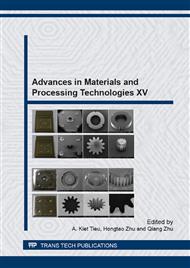p.471
p.478
p.488
p.496
p.503
p.512
p.518
p.525
p.534
Investigation of the Deformation Behaviour of a Thermoplastic Fibre Metal Laminate
Abstract:
Fibre metal laminates are sandwich materials comprised of a fibre-reinforced composite and a metal alloy. These advanced materials offer superior properties compared to the monolithic constituents; primarily, improved specific strength and stiffness compared to metals and improved impact and fatigue resistance when compared to composite materials. The use of these advanced materials is currently restricted to specialised applications where the superior properties justify the high cost of manufacturing. The formability of a fibre metal laminate based on a glass fibre reinforced polypropylene and an aluminium alloy is investigated in this study using techniques developed for the evaluation of metallic materials. Specimens of varying geometry were stretched over a hemispherical punch and an open die configuration was used to facilitate the acquisition of the strain using a using an optical measurement system. The experimental results were used to determine a forming limit diagram and to elucidate the safe forming limits of the material. In addition, the effect of specimen geometry on deformation behaviour was investigated by analysing the evolution of strain on the surface of the specimens. A significant finding of this study is that advanced materials such as fibre metal laminates can be formed in a similar manner to monolithic metals.
Info:
Periodical:
Pages:
503-511
Citation:
Online since:
November 2013
Keywords:
Price:
Сopyright:
© 2014 Trans Tech Publications Ltd. All Rights Reserved
Share:
Citation:


